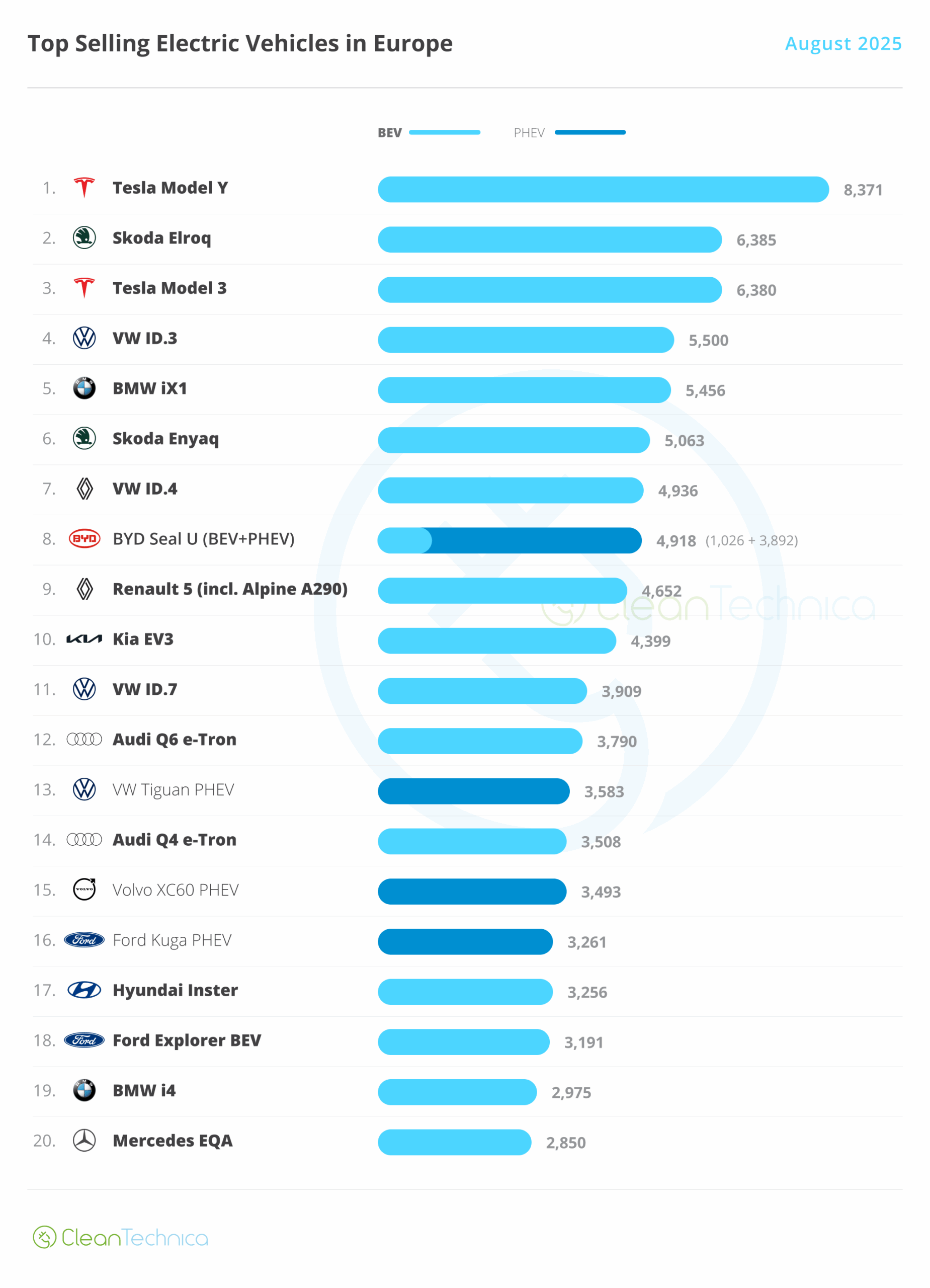Sign up for daily news updates from CleanTechnica on email. Or follow us on Google News!
At the end of October, BYD reported revenue for the months of July, August, and September that beat Tesla for the first time. In total, its quarterly revenue increased 24 percent to $28.2 billion, which fell short of estimates but exceeded Tesla’s $25.2 billion for the same period. Net income increased 11.5 percent to a record $1.6 billion, which did beat analysts’ estimates. During the quarter, BYD sold an unprecedented 1.12 million electric and plug-in hybrid vehicles and generated a gross margin of 21.9%. Its profit, however, is still overshadowed by the $2.2 billion Tesla earned in the third quarter.
BYD and Tesla have emerged as leading threats to legacy automakers, particularly as Volkswagen, Ford, Stellantis, and General Motors struggle to sell electric vehicles at a profit, as Bloomberg reports. As growth in consumer demand for fully electric cars has waned in some markets, BYD has been insulated more than Tesla due to its strong lineup of plug-in hybrid vehicles, including several so-called extended-range EVs that allow drivers to travel up to 600 miles or more on a combination of battery and combustion engine power. The Qin L sedan is notable for having a claimed combined range in excess of 1300 miles! Another key factor in the success of BYD is its vertically integrated supply chain. Making more parts in-house gives it a cost and scale advantage that allows it to produce more cars for less money than its competitors. Responding to the EREV lead that BYD has created, CATL announced recently it has developed a battery specifically designed to meet the needs of extended-range plug-in vehicles.
BYD Is Nipping At The Heels Of Tesla
Tesla, meanwhile, is dealing with a limited and increasingly stale BEV-only lineup and has been more focused on ramping up production of its Cybertruck and expanding the use of its partial-automation system marketed as Full Self Driving, Bloomberg says. Tesla’s AI potential and its lead in fully electric vehicle sales has helped cement its place as the world’s most valuable automaker. BYD comes in third, behind Toyota but ahead of VW, Mercedes, and the Detroit Big Three automakers.
It now appears that BYD is closing in on Ford in terms of the number of cars delivered. In October, BYD manufactured 534,003 vehicles, many of which were the plug-in hybrids that consumers who are still wary of EVs are more comfortable with. That volume of sales volumes puts BYD within shouting distance of surpassing Ford in total deliveries for 2024, a milestone that would cement its position as a top 10 automaker globally. Ford has been averaging around 1.1 million deliveries per quarter. “Getting to 4 million is a stunning milestone,” auto industry consultant Michael Dunne said, referring to BYD’s reported annual target. “BYD will soon be seeing Ford in the rear view mirror.” Dunne, a former General Motors executive, described the increase in BYD sales as “velocity without precedent.” It’s something we’ve been covering at length, and I’ve been told while sipping cucumber-watermelon juice in the lobby of CleanTechnica’s super secret Caribbean headquarters that another big story is going to drop soon.
BYD is benefiting from strong demand in China, which is being stoked by government subsidies that encourage people to trade in their older EVs or combustion engine cars for a newer vehicle. In addition, the BYD lineup of hybrids is resonating with consumers who aren’t quite ready to make the switch to a fully electric vehicle. The company’s third quarter set the tone for what is possible. The Shenzhen-based auto giant managed to outsell Ford by 40,000 units, delivering some 1.13 million mostly passenger cars, as well as a few thousand trucks and buses.
Investing In The Future
According to Reuters, BYD founder Wang Chuanfu is investing aggressively in research, which for 2024 could hit $6.5 billion. That’s nearly 50 percent higher than Tesla expects to spend. (You can also read about BYD’s R&D leadership here.) China accounted for the vast majority of BYD’s deliveries and growth in the first nine months of the year, helped by consumers’ taste for homegrown brands. Local brands accounted for nearly two-thirds of new car sales this year, compared with just one-third in 2020, according to industry consultancy Automobility.
Exports account for about 10 percent of BYD sales so far in 2024, despite a pushback against the influx of Chinese electric cars from the EU and the US. International markets could become the growth engine for the company as it readies factories in Hungary, Thailand, Turkey, and Brazil. For the first time in August, monthly sales filings showed BYD sold more cars abroad than it exported, indicating overseas production is already making a significant contribution to the company’s overall performance.
Tesla still beats BYD on some other counts, Reuters says. Its vast Shanghai factory achieved its lowest ever cost of goods per vehicle in the third quarter, which helped it record a net profit of $2.2 billion, which is higher than BYD’s $1.6 billion. Legacy carmakers like Ford are finding the competitive landscape increasingly difficult as Chinese automakers expand everywhere, from Southeast Asia to Europe and Latin America. Nissan, Volkswagen, and Stellantis are all confronting similar difficulties caused by shrinking profits, excess capacity, and too many employees.
Going Wide & Deep
BYD doesn’t sell passenger vehicles in the US, but that doesn’t seem to be holding the company back much, Reuters says. Senior Vice President He Zhiqi bragged on his Weibo account earlier this month that BYD increased production capacity by almost 200,000 units in the August to October period by hiring a large number of new employees for its assembly and components businesses. “BYD has no peer in the world right now,” Tu Le, founder of Detroit-based automotive advisory firm Sino Auto Insights told Reuters. “Legacy automakers just seem to be collateral damage as BYD goes like a freight train toward becoming the largest automaker in the world.”
Nissan, which was in the headlines for all the wrong reasons last week as it slashed payroll, production, and profitability forecasts for this fiscal year — may be another company that is about to take a back seat to BYD. The struggling Japanese automaker is on track to fall behind BYD in revenue this year.
BYD is also riding high in terms of the most valuable automakers by market capitalization. In June of 2022, when BYD’s Hong Kong–listed stock hit an all time high, the Chinese carmaker was worth more than Ford, GM, and Stellantis combined. It almost achieved that goal again last month as the woes affecting US automakers continued to mount. It didn’t quite get there, but with the way sales are trending, it may only be a matter of time, Reuters suggests.
There was a time when cracking the US market was critical to becoming a player in the auto market on the world stage, but with America erecting a tariff wall around itself designed to keep Chinese-made cars out, it seems unlikely that BYD or any other Chinese car company will be able to make significant inroads in the US. But that seems not to matter to the company, which is now selling cars, trucks, and buses in more than 70 countries around the world. Ford isn’t, GM isn’t, and Stellantis isn’t. Those companies can sit in splendid isolation in their magnificent US headquarters protected from competition by tariffs, but the bottom line is they are on the brink of becoming irrelevant on the global stage. And they seem to be comfortable with being big fish in a pond that is getting smaller all the time.

Chip in a few dollars a month to help support independent cleantech coverage that helps to accelerate the cleantech revolution!
Have a tip for CleanTechnica? Want to advertise? Want to suggest a guest for our CleanTech Talk podcast? Contact us here.
Sign up for our daily newsletter for 15 new cleantech stories a day. Or sign up for our weekly one if daily is too frequent.
CleanTechnica uses affiliate links. See our policy here.
CleanTechnica’s Comment Policy



